The Best Shrubs for Front of House Landscaping (With Pictures)

The best shrubs for the front of your house can greatly enhance your home’s curb appeal. Planting ornamental shrubs in the front yard provides privacy and structure and adds beauty and color. Growing evergreen shrubs provides year-round interest in a front yard garden landscape. Also, flowering shrubs that bloom in various seasons are perfect for curb appeal landscaping.
This article is a guide to the best shrubs for the front of your house. Descriptions and pictures of medium or small-sized front yard shrubs will help you select the perfect plants to create an inviting and attractive entrance to your home. Additionally, tips on caring for landscaping shrubs ensure your front yard always looks healthy and lush.
What Are Shrubs for Front of House Landscaping?
Front yard shrubs are attractive bushy plants with great ornamental value. Shrubs for the front garden can be flowering bushes, evergreen shrubs, small conifers, or perennials. Ideally, front-of-house shrubs should be easy to maintain, add to your home’s curb appeal, and not grow too high.
Boxwoods and coniferous shrubs are the best evergreen shrubs for planting along a fence line, driveway, or front lawn. Spectacular flowering shrubs with a long blooming season include azaleas, hydrangeas, shrub roses, and camellias. Even if your front yard is north-facing, shrubs for shade can brighten your garden.
The Best Shrubs for Planting at the Front of the House
Read on to learn about some of the best shrubs for planting in the frontage area of your house. Knowing which plants to choose and how to care for them is essential for creating a beautiful and inviting entrance.
Boxwood Shrubs (Buxus)

Boxwood shrubs are popular landscaping evergreen plants for adding structure to front-of-house landscapes. Ideal for sun or shade, versatile boxwood shrubs are known for their dense, compact growth habit and small, glossy green leaves. Boxwoods are easy to prune, making them popular for front-of-house hedges, topiaries, and formal landscapes.
Boxwood shrubs are low-maintenance and drought-tolerant once established. They grow 1 to 5 ft. (0.3 – 1.5 m) tall.
These hardy shrubs are deer-resistant and can withstand cold temperatures. Some varieties have a compact, rounded shape. In contrast, others have a conical or pyramidal shape—perfect for adding definition to driveways, paths, or containers at a front door. With their year-round green foliage, boxwood shrubs provide color and structure to any landscape.
USDA Zone: 5 to 9
Sun Exposure: Full sun, partial shade, or deep shade
Soil Type: Well-drained, evenly moist soils
Dwarf Korean Lilac (Syringa meyeri ‘Palibin’)
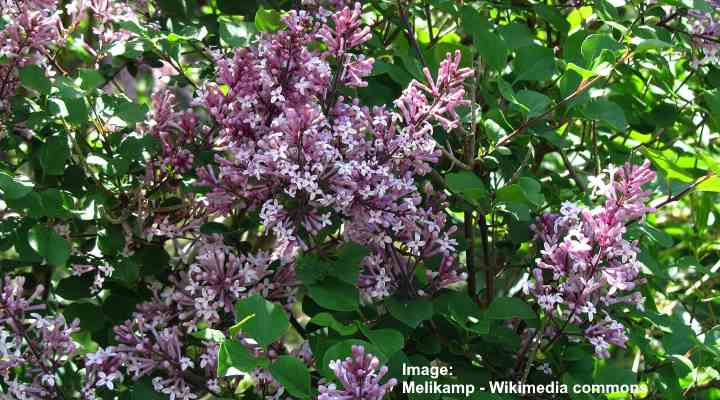
Dwarf Korean lilac is a compact deciduous shrub that fills sunny front yards with showy blooms in late spring and early summer. The compact shrub is identified by its small, star-shaped lavender-pink flowers growing in dense, upright clusters. The broadly-ovate green leaves turn reddish-bronze in the fall, adding to its seasonal interest.
Dwarf lilac shrubs grow 4 to 5 ft. (1.2 – 1.5 m) tall and have a dense, rounded, spreading shape. Many dwarf lilac species are slow-growing and tolerant of urban conditions. They are low-maintenance and drought, heat, and deer resistant.
USDA Zone: 3 to 7
Sun Exposure: Full sun to light shade
Soil Type: Well-drained, fertile, humus-rich, dry to medium soil
Butterfly Bush (Buddleja davidii)
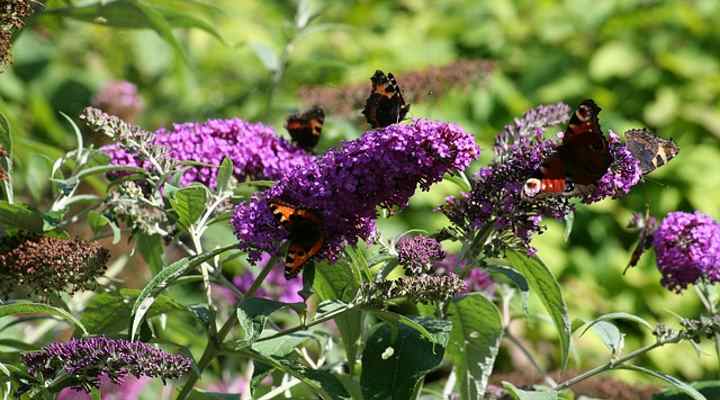
Butterfly bush is a deciduous sun-loving shrub ideal for front-of-house planting thanks to its long, cone-shaped clusters of fragrant, colorful flowers. The free-flowering arching clusters bloom throughout the summer and fall in purple, lilac, red, yellow, and white shades. Butterfly bush grows 3 to 5 ft. (1 – 1.5 m) tall.
Butterfly bush is a popular shrub to attract pollinators, especially butterflies, to front yards. In addition to its long-lasting vibrant blooms, the butterfly bush has gray-green leaves that add texture to the garden. It’s ideal for planting along a foundation line, shrub borders, and containers. Deadheading the shrub extends its blooming period to the first frost.
USDA Zone: 5 to 9
Sun Exposure: Full sun
Soil Type: Well-drained, medium moisture soils
Winterberry (Ilex verticillata)
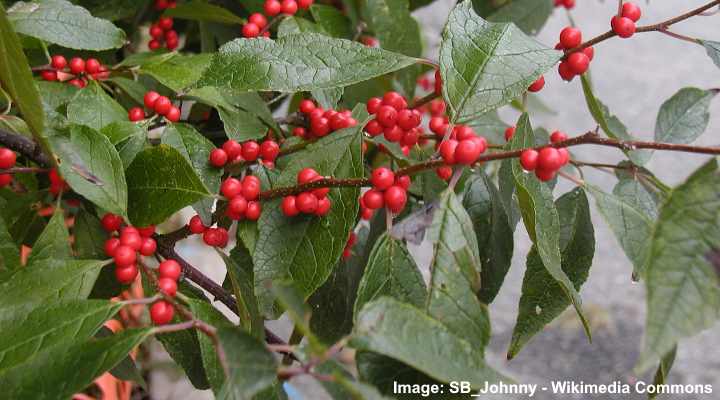
Winterberry is a slow-growing deciduous shrub ideal for hiding a front foundation line. It’s also famous for its masses of red berries in winter. Native to North America, winterberry has greenish-white spring flowers, lush, leathery, dark green leaves, and brightly colored red berries. It’s an ideal shrub for planting in groupings in a front yard.
Winterberry grows 6 to 10 ft. (1.8 – 3 m) tall and wide. Its tolerance to boggy soil makes it ideal for planting near a pond, stream, or in a front yard with poor drainage. Its main ornamental appeal is its eye-catching red berries that brighten fall and winter gardens.
One important thing to note is that winterberry is dioecious, meaning you need both a male and a female plant to get berries. Only the female plant produces berries, so plant at least one male plant nearby for pollination.
USDA Zone: 3 to 9
Sun Exposure: Full sun to light shade
Soil Type: Moist, acidic soil, and it tolerates poorly-drained soils
Dwarf Japanese Garden Juniper (Juniperus procumbens ’Nana’)
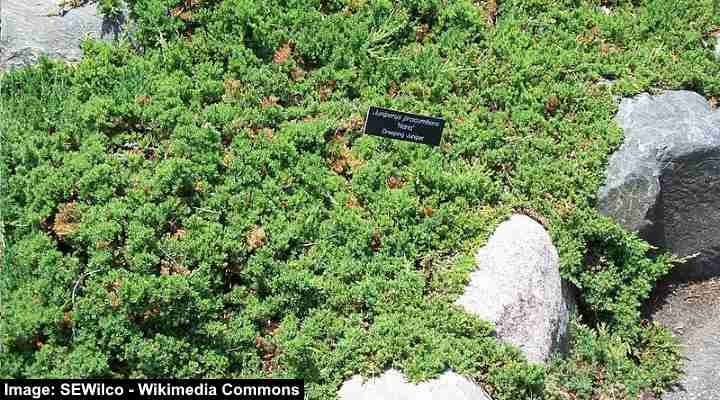
Dwarf Japanese garden juniper ‘Nana’ is ideal for ground cover in front-of-house landscaping due to its low-growth and evergreen foliage. The mat-forming coniferous shrub keeps its blue-green color throughout the year. You can plant the spreading shrub to cascade over a wall, line a driveway, or add texture to a front-of-house foundation line.
The dwarf juniper ‘Nana’ cultivar grows 6” to 12” (15 – 30 cm) tall and up to 6 ft. (1.8 m) wide. With its dense, evergreen foliage, the slow-growing shrub is easy to maintain and doesn’t require pruning. It’s resistant to most pests and diseases.
USDA Zone: 4 to 9
Sun Exposure: Full sun
Soil Type: Well-drained soil that retains average to medium moisture
Dwarf Hinoki Cypress (Chamaecyparis obtusa ‘Nana’)
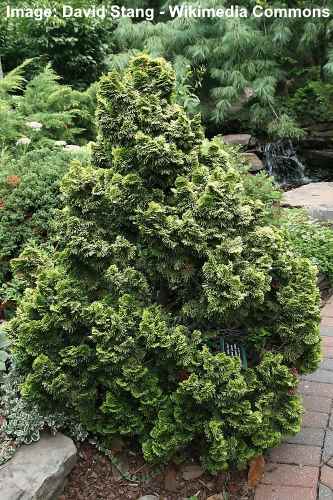
Dwarf Hinoki cypress cultivar ‘Nana’ is popular for front-yard landscaping due to its distinctive pyramidal shape and dense foliage. This sun-loving, slow-growing shrub has small scale-like leaves arranged in flattened sprays and reddish-brown cones. This dwarf shrub grows 3 to 6 feet (1 – 1.8 m) tall with a spread of 2 to 4 feet (0.6 – 1.2 m).
This dwarf cypress is a versatile plant that can be used in various front garden settings. The low-growing evergreen shrub is well-suited for colder climates. It can tolerate frost and snow, making it an excellent choice for front-yard planting in various regions.
USDA Zone: 4 to 8
Sun Exposure: Full sun
Soil Type: Moist, well-drained soil
Dwarf Alberta Spruce (Picea glauca ‘Conica’)
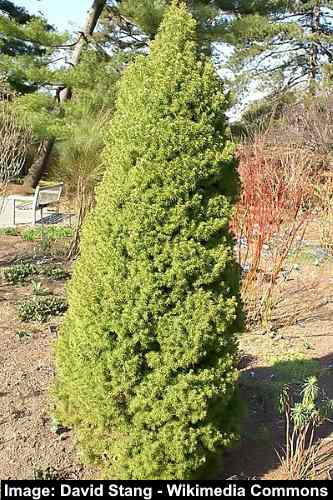
Dwarf Alberta spruce cultivar ‘Conica’ is commonly used in front yard landscapes due to its cone shape, dense foliage, and compact nature. Thriving in full sun, the slow-growing shrub has fine blue-green needle leaves. This popular landscaping conifer grows 3 to 4 feet (1 to 1.2 m) tall and up to 1.5 ft. (0.5 m) wide.
The popularity of the dwarf Alberta spruce shrub is thanks to its low-maintenance and minimal pruning requirements. It performs best in sunny, cool climates. Its slow growth means it only grows 4” (10 cm) annually. Growing 4 ft. (1.2 m) tall takes about ten years. However, it takes several decades to reach its mature height of 13 ft. (4 m) tall and 10 ft. (3 m) wide.
Dwarf Alberta spruce shrubs perform well in containers, rock gardens, and sunny borders.
USDA Zone: 2 to 6
Sun Exposure: Full sun to partial shade
Soil Type: Well-drained soil
Dwarf Blue Spruce (Picea pungens ‘Montgomery’)
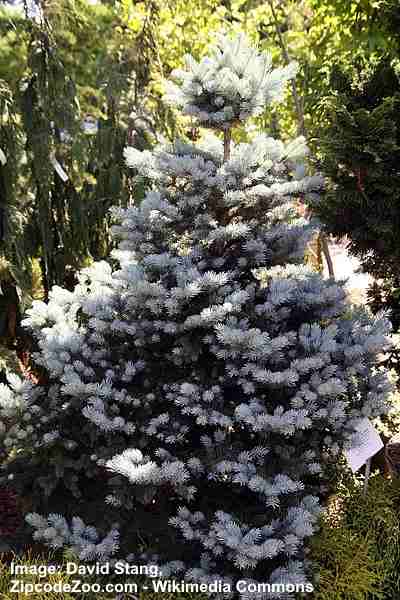
Dwarf blue spruce ‘Montgomery’ cultivar is a versatile compact evergreen shrub for planting at the front of a house. The pyramidal conifer has blue-green needle leaves growing on horizontal branches. It also produces 4” (10 cm) long cylindrical light brown cones. The dwarf conifer grows slowly and matures at 3 to 4 ft. (1 – 1.2 m).
Dwarf blue spruce is a low-maintenance shrubby plant that doesn’t need pruning. Landscaping uses include foundation planting, an evergreen hedge, or a specimen shrub. Its distinct blue-green color complements a variety of landscaping designs.
USDA Zone: 3 to 7
Sun Exposure: Full sun or light shade
Soil Type: Well-drained acidic soil that retains medium moisture
Yew (Taxus spp.)
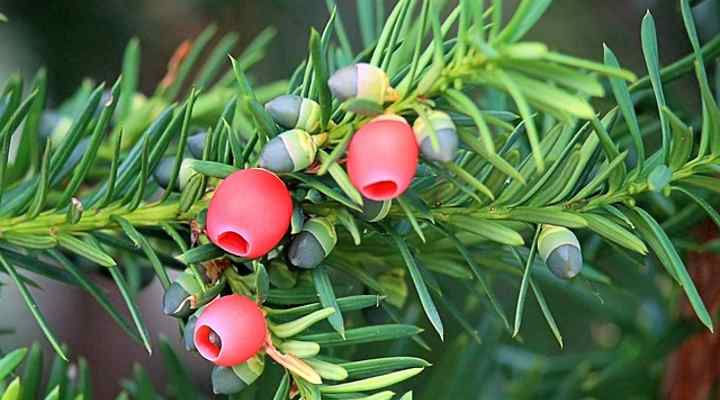
Several evergreen yew shrubs have ornamental qualities, making them ideal for front-of-house landscaping. The shade-tolerant shrubs can be upright, columnar plants for adding a vertical accent to a property’s frontage. Or the evergreen shrubs can be low-growing, spreading plants for ground cover or texture along a foundation line.
Here are three yew shrubs suitable for front-yard landscaping:
English yew ‘Standishii’ (Taxus baccata ‘Standishii’): The shrub is narrowly columnar with an upright growth habit. Ideal for growing at the corner of a house or a container beside an entranceway, the splendid yew grows 4 to 5 ft. (1.2 – 1.5 m) tall and 2 ft. (0.6 m) wide.

English yew ‘Standishii’ (Taxus baccata ‘Standishii’)
Anglo-Japanese yew ‘Densiformis’ (Taxus x media ‘Densiformis’): The mounding conifer has a rounded growth habit and glossy green needle leaves. Its low-growth habit makes it perfect for foundation planting or a small hedge to define a front landscape. It grows 3 to 4 ft. (1 – 1.2 m) tall.
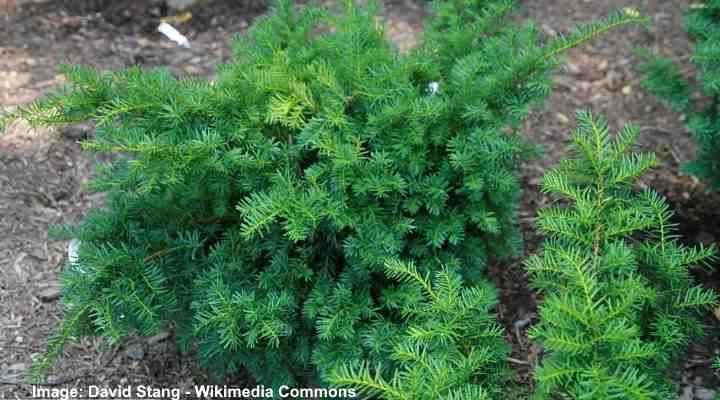
Anglo-Japanese yew ‘Densiformis’ (Taxus x media ‘Densiformis’)
English yew ‘Repens Aurea’ (Taxus baccata ‘Repandens Aurea’): This wide-spreading evergreen shrub is perfect for a front of house planting due to its low growth. The slow-growing shrub has bright, glossy yellowish-green leaves and coral-red seed-bearing cones. The front-yard shrub grows up to 4 ft. (1.2 m) tall and 15 ft. (4.5 m) wide.
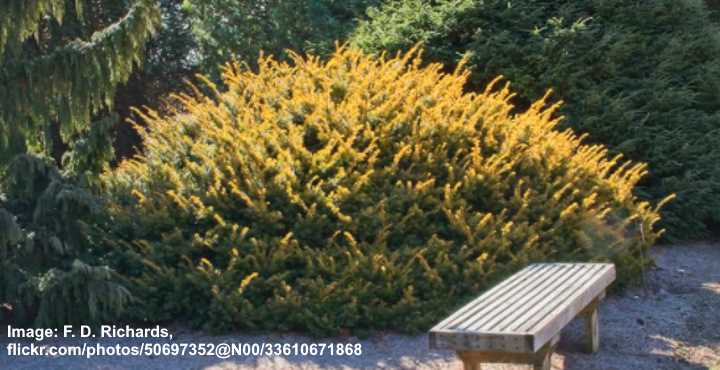
English yew ‘Repens Aurea’ (Taxus baccata ‘Repandens Aurea’)
Ninebark (Physocarpus opulifolius)
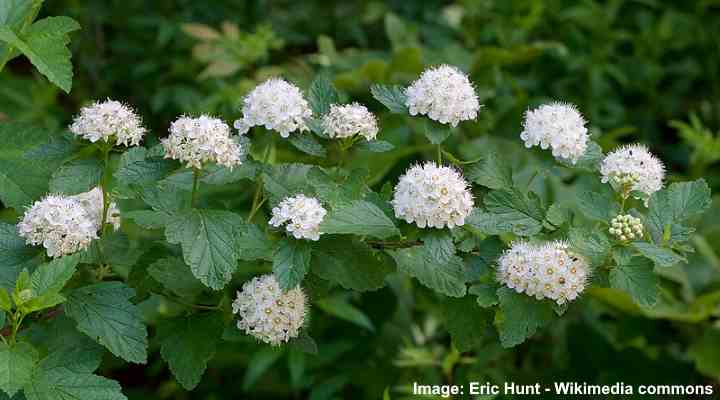
Ninebark is a fast-growing deciduous shrub that adds beauty and interest to any front yard. This versatile shade-tolerant shrub has an attractive semi-dome shape, fuzzy white flowers in dense clusters, and green lobed leaves. This ornamental shrub brightens partially shaded front yards with its yellow foliage in the fall.
Ninebark grows 5 to 8 feet (1.5 – 2.4 m) tall and 6 ft. (1.8 m) wide. Interesting ornamental features of the shrub are its creamy-white, pink-tinged flowers that bloom in late spring through summer. After blooming, small red or brown fruit capsules appear, adding further visual interest to the plant. Additionally, it has peeling bark that reveals reddish-brown inner bark.
USDA Zone: 2 to 8
Sun Exposure: Full sun to partial shade
Soil Type: Slightly acidic, dry to medium moisture soils that have excellent drainage
Knock Out Roses (Rosa ’Knock Out’)
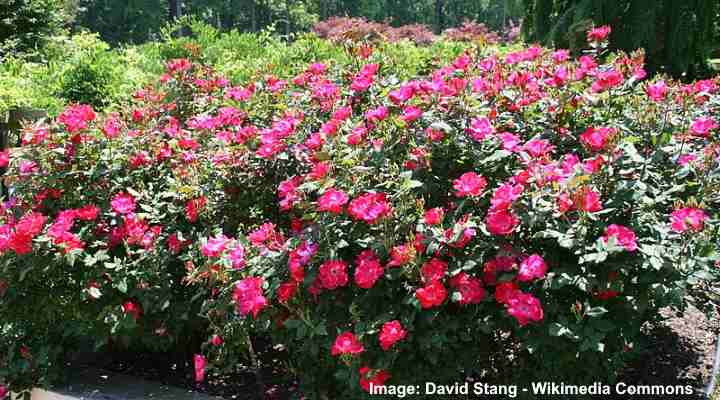
Also called shrub roses, these stunning flowering compact plants fill sunny front yards with abundant flowers throughout summer. Knock Out roses are popular for front-of-house landscaping because they add vibrant colors and foliage that don’t wilt in the summer heat. Their compact habit also makes them ideal for small gardens or containers.
Blooming continuously from spring until frost, the stunning flowering shrubs are winter-hardy and resistant to pests and diseases. The brightly colored fragrant flowers attract pollinators like bees and butterflies. These low-maintenance roses are ideal as a colorful security hedge, foundation planting, or for enhancing curb appeal.
USDA Zone: 5 to 11
Sun Exposure: Full sun to partial shade
Soil Type: Rich, fertile soils that have excellent drainage
Little Gem Southern Magnolia (Magnolia grandiflora ‘Little Gem’)
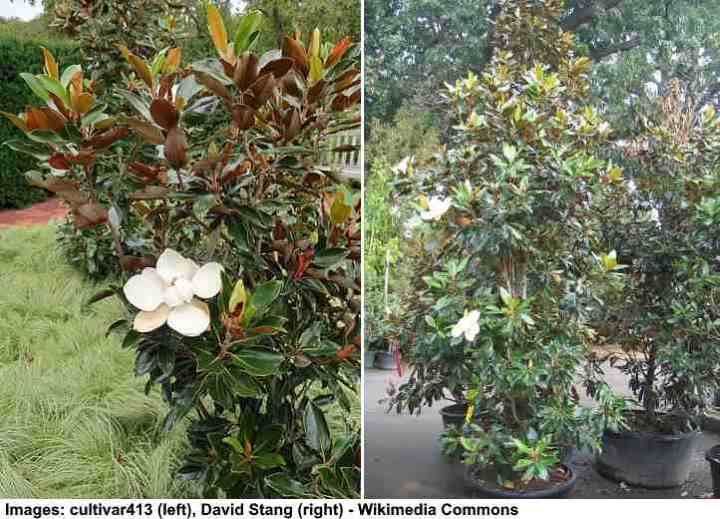
The ‘Little Gem’ southern magnolia cultivar is a compact flowering evergreen shrubby plant to create a warm and inviting entrance in your front-of-house area. Magnolias are prized for their beautiful, fragrant white flowers. The brilliant white flowers have oval or pointed petals contrasting nicely with glossy green, leathery leaves.
The attractive evergreen shrub grows 15 to 20 ft. (4.5 – 6 m) tall and 10 ft. (3 m) wide.
The southern magnolia ‘Little Gem’ blooms from late spring to mid-summer, filling front-of-house landscapes with delicate scents. Its large, showy flowers measuring 8” (20 cm) wide and its pyramidal or rounded shape make it a great shrub for foundation plantings or focal points. It’s also ideal for urban landscapes, planting near patios or decks for shade.
USDA Zone: 7 to 9
Sun Exposure: Full sun to partial shade
Soil Type: Organically rich, moist, well-drained soil
Azaleas (Rhododendron spp.)
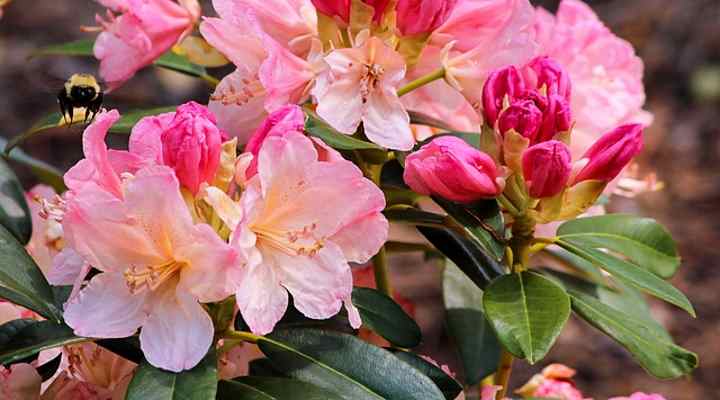
Azaleas are elegantly landscaped entrance plants that bloom abundantly throughout the summer. The beautiful flowering shrubs are known for their showy clusters of vibrant, trumpet-shaped blooms. The best azaleas for front yards are tall varieties that grow 4 to 6 ft. (1.2 – 1.8 m) and bloom in spring and rebloom in summer and fall.
These flowering shrubs prefer partial shade and well-drained, acidic soil. They are relatively low-maintenance plants but require regular watering and occasional pruning to maintain their shape. You can plant azaleas in borders, hedges, and part of front-of-house foundation planting. Azaleas also grow well in containers to brighten patios or balconies.
USDA Zone: 5 to 9
Sun Exposure: Partial shade
Soil Type: Well-drained, acidic, humus-rich soil
Hydrangeas (Hydrangea)
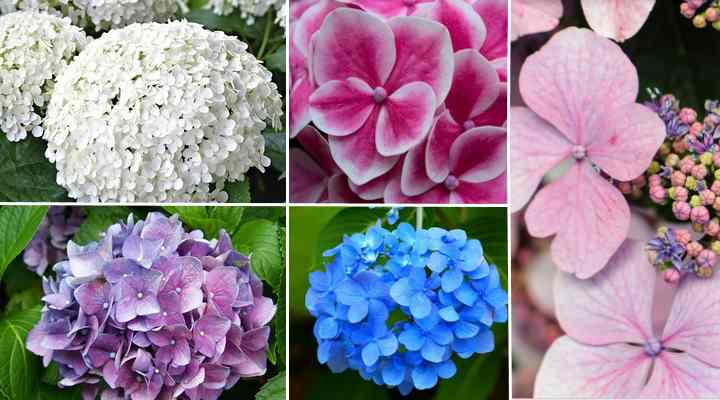
Hydrangeas are popular flowering shrubs that work well as ornamental plants in front yards. Known for their large, showy blooms, hydrangeas bloom with large pink, blue, purple, and white flowers. The flowers on the low-maintenance shrubs can also change color depending on the soil pH levels.
Smooth Hydrangeas (Hydrangea arborescens)
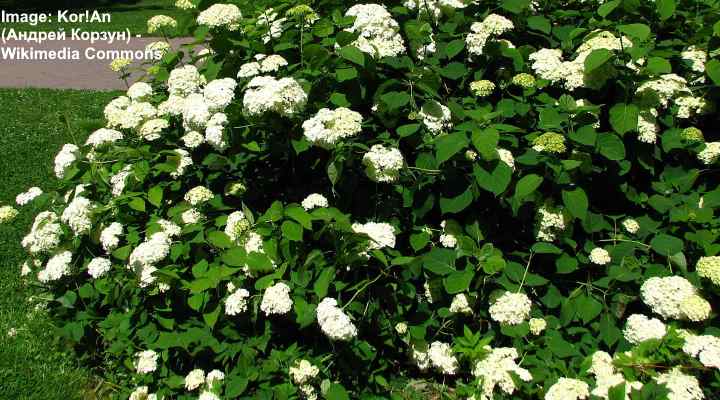
Smooth hydrangeas are deciduous shrubs producing large, showy globe-like flower heads to beautify front yards. These flower clusters can grow up to 12” (30 cm) in diameter. The white and pink flowers bloom from late spring for two months. Smooth hydrangeas grow 3 to 4 ft. (1 – 1.2 m) tall and wide. They thrive in USDA Zones 3 to 8.
Panicle Hydrangeas (Hydrangea paniculata)
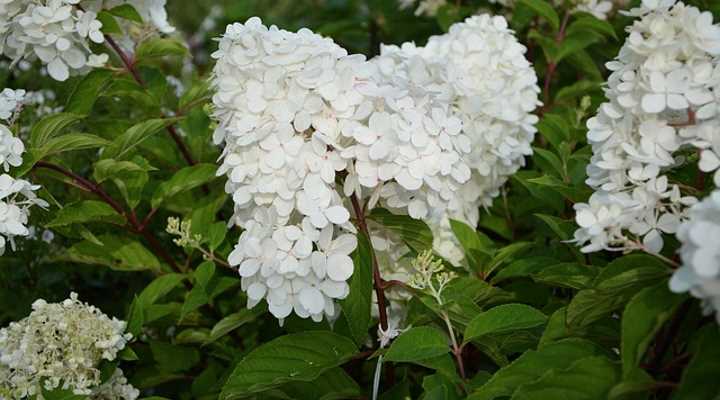
Panicle hydrangeas look superb in front-of-house landscapes thanks to their large, cone-shaped flower clusters. These showy flowers bloom in various colors, including white, pink, and shades of green. Known for their hardiness and ability to thrive in a wide range of climates and soil conditions, panicle hydrangeas are long-blooming ornamental shrubs.
Panicle hydrangeas thrive in USDA Zones 3 to 8 and grow 10 to 25 ft. (3 – 7.5 m) tall.
Blue Mist Shrub (Caryopteris x clandonensis)

Blue mist is a deciduous shrub for front-of-house landscaping, producing clusters of small purple-blue flowers. Also called bluebeard, the sun-loving shrub blooms in late summer with flowers resembling blue mist or smoke. This compact and drought-tolerant plant is a popular choice for adding color to front garden landscapes.
Blue mist shrubs grow 2 to 3 ft. (0.6 – 1 m) tall and wide. Other ornamental features of the small shrub are its gray-green foliage, fuzzy blue flower clusters, and winged fruits. The fragrant blue flowers also attract beneficial insects like bees and butterflies.
USDA Zone: 5 to 8
Sun Exposure: Full sun to partial shade
Soil Type: Well-drained soil
Virginia Sweetspire (Itea virginica)
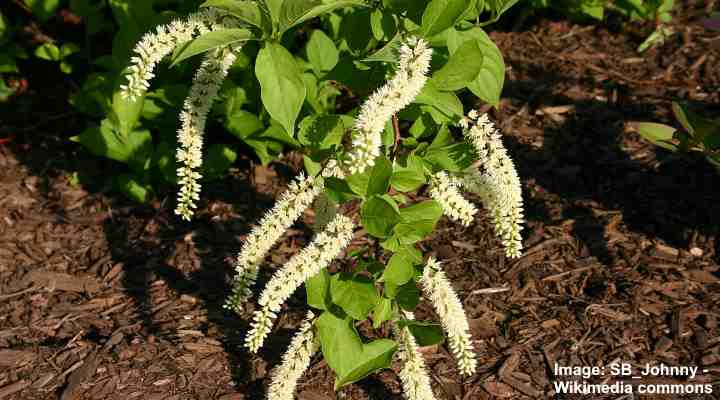
Virginia sweetspire is a deciduous shrub popular for planting in front of a house in the shade or sun. The eye-catching fragrant white flowers are cylindrical clusters resembling bottlebrushes. Blooming in spring and lasting until fall, the white flowers attract pollinators like bees and butterflies. Virginia sweetspire grows 3 to 10 ft. (1 – 3 m) tall and wide.
Virginia sweetspire has arching branches covered with lustrous rich green leaves. In the fall, the attractive foliage turns red, orange, or purple to add color and texture to front gardens. This versatile ornamental shrub is easy to grow and resistant to pests, diseases, and soggy ground.
USDA Zone: 5 to 10
Sun Exposure: Full sunlight to partial shade
Soil Type: Well-drained, acidic soils; however, it also tolerates swampy ground and soil with poor drainage
Japanese Barberry (Berberis thunbergii)

Japanese barberry is a red-leaved deciduous shrub to add vibrancy to front-of-house foundation plantings. Thriving in direct sunlight or partial shade, the small shrub is characterized by its small wedge-shaped, reddish-purple leaves, pale yellow spring flowers, and bright red fall berries. This low-growing decorative shrub grows 2 to 6 ft. (0.6 – 1.8 m) tall.
Japanese barberry has many uses in a front yard landscape. Its jagged branches make it an ideal barrier or security hedge. Additionally, its red foliage adds visual interest to fall and winter gardens. And its low and shrubby growth make it perfect for ground cover or lining a driveway.
Other Japanese barberry cultivars for front-yard landscaping include the following:
- Berberis thunbergii f. atropurpurea ‘Admiration’ has stunning coral-red leaves with bright yellow margins.
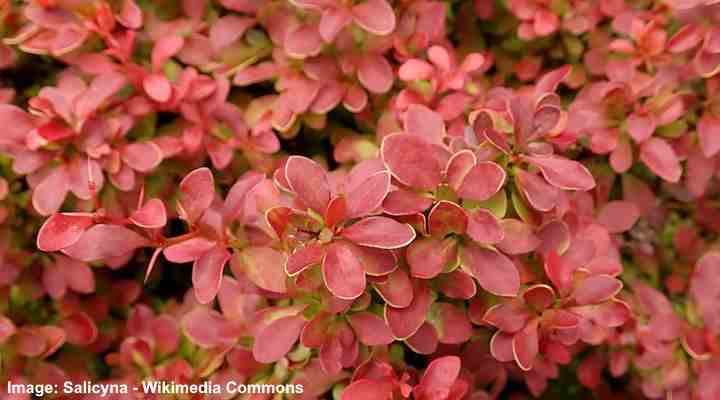
Berberis thunbergii f. atropurpurea ‘Admiration’
- Berberis thunbergii ‘Golden Rocket’ is a compact, upright shrub with chartreuse leaves and eye-catching red stems.
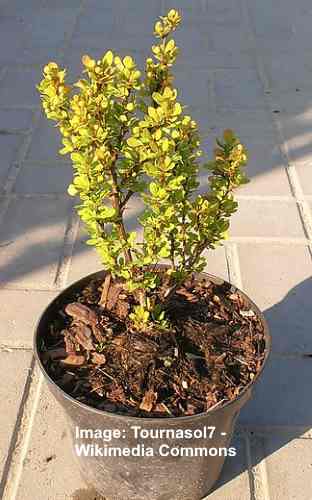
Berberis thunbergii ‘Golden Rocket’
- Berberis thunbergii ‘Atropurpurea Nana’ is a bushy shrub with reddish or purple leaves and small oval red berries. It doesn’t grow taller than two feet (0.6 m) tall.

Berberis thunbergii ‘Atropurpurea Nana’
USDA Zone: 4 to 8
Sun Exposure: Full sunlight or partial shade
Soil Type: Dry to medium, well-drained soils
Compact Burning Bush (Euonymus alatus ‘Compactus’)

Compact burning bush transforms a sunny front-of-house area into a vibrant space thanks to its spectacular bright red fall foliage. The landscaping features of the ornamental bush are its elliptic green leaves in spring and summer, decorative purplish-red berries, and greenish flowers. The compact shrub grows 9 to 10 ft. (2.7 – 3 m) tall and wide.
As the weather cools in the fall, the front-yard shrub turns a brilliant shade of fiery red. Its vase shape and multiple stems also provide the bare shrub with ornamental value during winter, with many deep red fruits persisting for several months. The shrub tolerates partial shade and is resistant to deer.
USDA Zone: 4 to 9
Sun Exposure: Full sun to partial shade
Soil Type: Well-drained soil
Golden Euonymus (Euonymus japonicus ‘Aureo-marginatus’)

Golden euonymus brightens partially shaded front yards with yellow and green variegated foliage. Characteristics of the versatile shrub include oval-shaped green leaves with golden-yellow margins, small, inconspicuous spring flowers, and showy pink or red fruits in the fall. Golden euonymus grows 5 to 10 ft. (1.5 – 3 m) tall.
In full sun or partial shade, you can plant the easy-care Golden euonymus as a hedge, foundation planting, or as a specimen plant.
USDA Zone: 6 to 9
Sun Exposure: Full sun to partial shade
Soil Type: Fertile, humus-rich, well-drained soils
Smokebush (Cotinus coggygria)
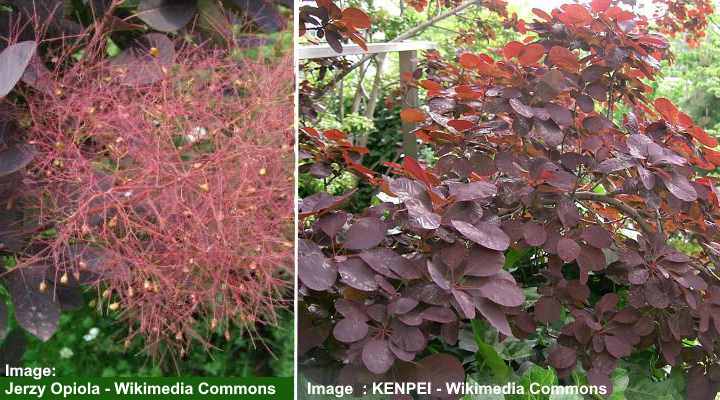
Smokebush is a deciduous shrub with ornamental features for landscaping a sunny front yard. This purple-leaved shrub has unique flowers that resemble pinkish-purple smoky puffs. In the fall, the leaves turn vibrant shades of orange, red, or yellow, adding a burst of color to front-of-house landscapes.
When blooming in late spring, the unusual flower clusters resemble puffs of smoke. These clusters consist of tiny flowers with feathery filaments that give them their dusty appearance. Depending on the variety, the flowers can range from creamy white to pinkish-red.
Smokebush shrubs grow 10 to 15 ft. (3 – 4.5 m) tall and wide and are drought tolerant.
USDA Zone: 4 to 7
Sun Exposure: Full sun to partial shade
Soil Type: Various soil types that drain well
Japanese Skimmia (Skimmia japonica)
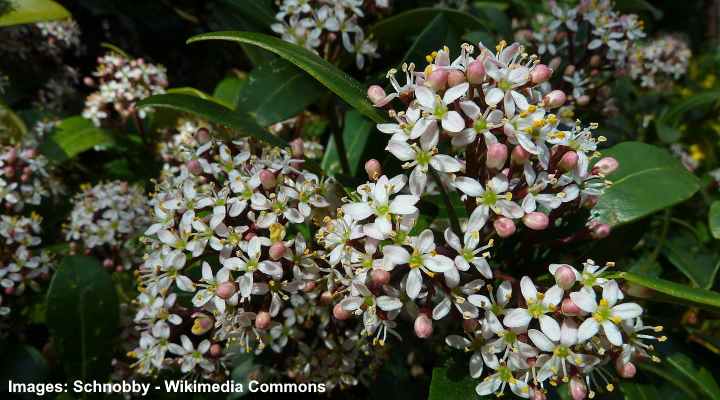
Japanese skimmia is a versatile evergreen shrub, ideal for front-of-house landscaping in shaded areas. Ornamental features of this attractive shrub are its clusters of star-shaped creamy white fragrant flowers, bright red berries, and luscious leathery, aromatic leaves. Japanese skimmia grows 3 to 4 ft. (1 – 1.2 m) tall.
Slow-growing Japanese skimmia is ideal for growing on the north-facing side of a house or fence line. The evergreen shrub also grows as an attractive evergreen hedge, foundation plantings, shrub borders, specimen, or container plant.
USDA Zone: 6 to 8
Sun Exposure: Partial shade to full shade
Soil Type: Well-drained, acidic, humus-rich soil
Dwarf Russian Almond (Prunus tenella)

Dwarf Russian almond is a cold-hardy, sun-loving shrub that fills front yards with pink-reddish spring flowers. This small, compact shrub features showy flower clusters, lustrous foliage that turns golden yellow in the fall, and velvety oval fruits. The dwarf shrub grows 2 to 5 ft. (0.6 – 1.5 m) tall and wide, making it suitable for planting at the front of the house.
Dwarf Russian almond is a beautiful and versatile plant that adds color and interest from spring through fall in front garden landscapes. It’s fast-growing, averaging 1 to 2 ft. (0.3 – 0.6 m) of growth annually. Its early spring blooms and attractive foliage make it popular for front-yard foundation planting.
USDA Zone: 2 to 6
Sun Exposure: At least six hours of direct sunlight daily
Soil Type: Well-drained, humus-rich soil; it tolerates some drought
Red Osier Dogwood (Cornus sericea)
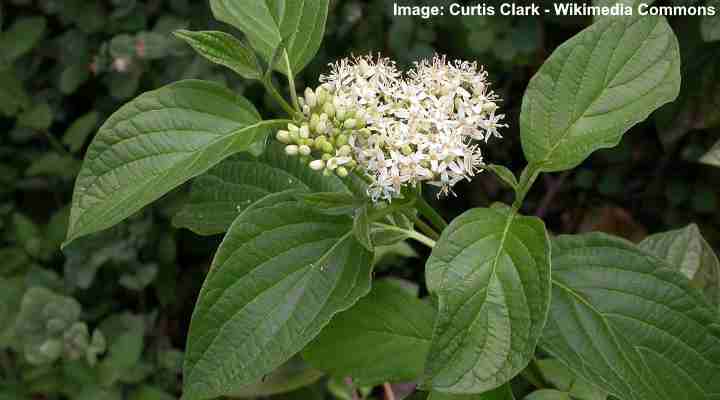
Red osier dogwood is a shade-tolerant shrub that adds a pop of red color in winter to front yards thanks to its striking red branches. The multi-stemmed shrub has rapid growth and produces small flat-topped clusters of creamy-white flowers, attractive berries, and its characteristic vibrant red stems.
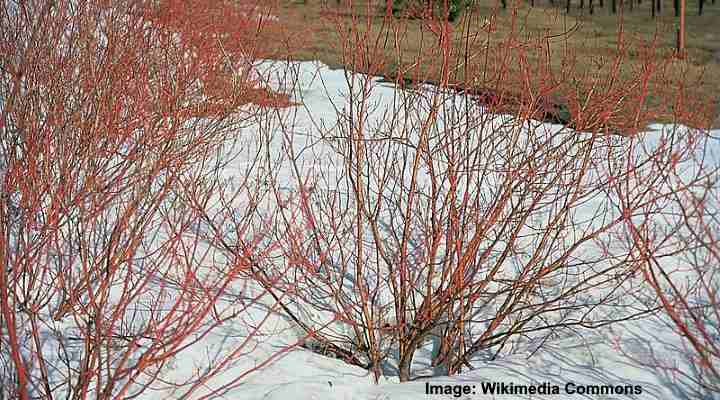
Red osier dogwood in winter
Also called red willow, the versatile shrub thrives in part shade and medium to wet soils. It is highly adaptable to various soil types and moisture conditions. It has tremendous ornamental value in winter to boost curb appeal and enhance a front yard.
USDA Zone: 3 to 8
Sun: Full sun, partial shade, or full shade
Soil: Moist, well-drained soils; however, it can tolerate soggy soils
Heavenly Bamboo (Nandina domestica)
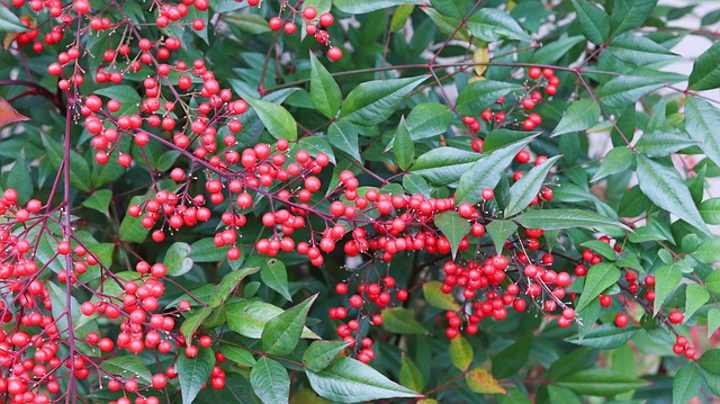
Heavenly bamboo is a tough, evergreen shrub that adds color and interest to any front yard. The small shrub is known for its arching white flower clusters, vibrant red berries, and ornamental foliage that emerges purple before turning green. Heavenly bamboo grows 4 to 8 feet (1.2 – 2.4 m) tall.
This versatile plant performs well as an informal hedge or privacy screen. But you can also plant it in shrub borders, foundation plantings, or woodland gardens. Heavenly bamboo is drought-tolerant once established.
It’s important to know that heavenly bamboo is toxic to all animals, including dogs and cats. In some southeastern states, the multi-stemmed shrub is invasive.
USDA Zone: 6 to 9
Sun Exposure: Full sun to partial shade
Soil Type: Well-drained soil
Viburnum (Viburnum spp.)
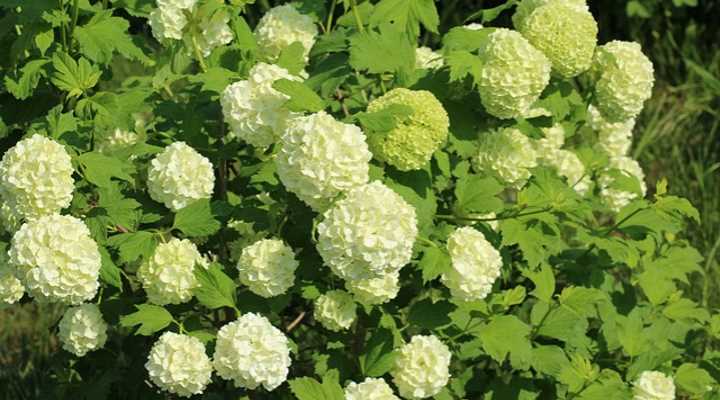
Viburnum is a genus of flowering shrubs with several landscaping options for front-of-house planting. Thriving in full sun, viburnum shrubs are known for their large colorful flower clusters. The eye-catching spring blooms are in shades of white or pink. These compact shrubs also produce red, blue, or black berries.
Viburnums have a mounding habit, reaching heights of 4 to 10 ft. (1.2 – 3 m) tall and wide (depending on the cultivar). The densely-packed snowball-like flowers contrast nicely with the glossy green, leathery lanceolate leaves.
USDA Zone: 4 to 8
Sun Exposure: Full sun to partial shade
Soil Type: Well-drained soil with medium moisture
Inkberry (Ilex glabra)
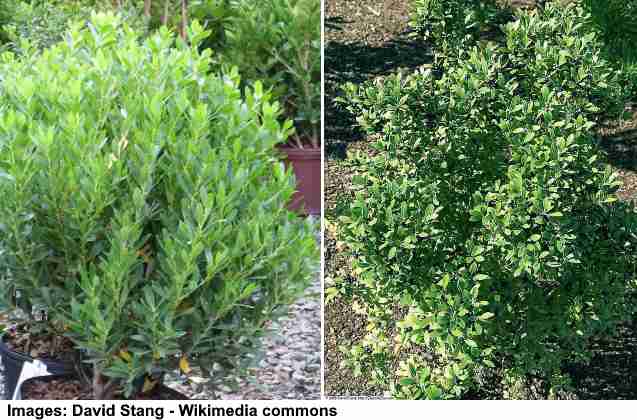
Ilex glabra ‘Shamrock’ (left) and ‘Pretty Girl’ (right)
Inkberry is a versatile evergreen shrub, ideal for planting in front yards with poor drainage. The evergreen shrub thrives in full sun or partial shade. The slow-growing rounded shrub has glossy, dark green leaves, insignificant white flowers, and jet-black berry-like drupes. Inkberry shrubs grow 5 to 8 ft. (1.5 – 2.4 m) tall and wide.
Inkberry shrubs are salt-tolerant, making them a good choice for coastal gardens. The low-growing evergreen plant is ideal for foundation planting, growing a low hedge, or planting in a shrub border. It’s a good landscape solution for growing in wet soil.
USDA Zone: 4 to 9
Sun Exposure: Full sun or partial shade
Soil Type: Average soils that are medium moisture to wet or boggy
Japanese Holly ‘Sky Pencil’ (Ilex crenata ‘Sky Pencil’)
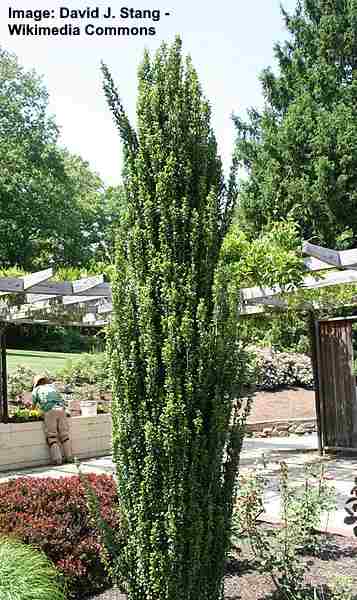
Japanese holly ‘Sky Pencil’ is an evergreen shrub that adds a vertical accent to a front-of-house garden landscape. The distinctive plant has a narrow, columnar growth habit—hence the name ‘Sky Pencil.’ Its branches are fastigiate—growing upward vertically to the trunk. It also produces tiny white flowers and black berries.
The ‘Sky Pencil’ Japanese holly cultivar grows 6 to 10 feet (1.8 – 3 m) tall and only 2 to 3 feet (0.6 – 1 m) wide. Its pencil-thin growth habit is ideal for growing in containers beside a front entranceway. However, it also performs well as a narrow hedge, foundation planting, or accenting the corner of a house.
USDA Zone: 6 to 8
Sun Exposure: Full sun to partial shade
Soil Type: Average well-drained soil with medium moisture
Japanese Andromeda (Pieris japonica)
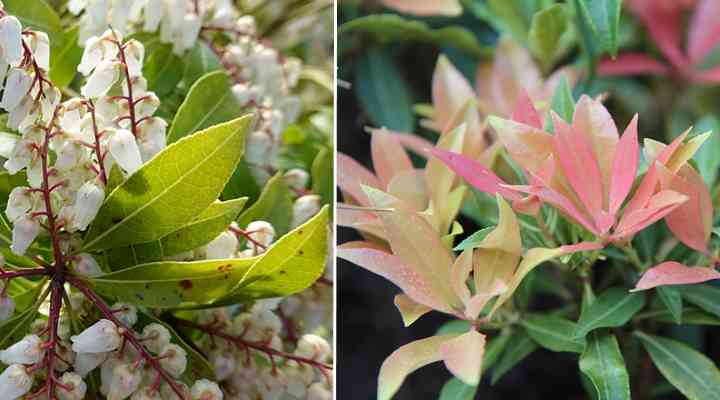
Japanese Andromeda is suitable for a front-of-house landscape due to its attractive young pink-red leaves that turn green when they mature, and pinkish-white spring blooms. Also called lily-of-the-valley shrub, the plant’s flowers are urn-shaped and grow in clusters.
Japanese Andromeda is a popular ornamental shrub in landscaping, reaching a height of 8 to 10 ft. (2.4 – 3 m) with a compact, rounded form. There are also dwarf variations of Japanese Pieris, such as the ‘Cavatine’ cultivar, which only grows to 3 ft. (1 m) in height.
Decorative features of Japanese Pieris include rosette-like leaves that turn yellow in the fall, showy clusters of lily-of-the-valley flowers, and golden-yellow stems that turn green.
USDA Zone: 4 to 8
Sun Exposure: Partial shade to full shade
Soil Type: Moist, well-drained soil with high organic matter
Sweetshrub (Calycanthus venus)

Sweetshrub is a compact shrub with showy white flowers, ideal for planting in small front yards. The decorative features of the white-flowering shrub are its magnolia-like white and purple blossoms, dark green oval leaves, and attractive yellowish fall colors. Sweetshrub flowers bloom from late spring to early summer.
Sweetshrub plants can grow 5 to 7 ft. (1.5 – 2.1 m) tall and wide. They are characterized by their rounded, dense growth habit, highly fragrant white flowers, and lustrous foliage. Sweetshrub is a low-maintenance shrub that performs well along a foundation line or in a front yard shrub border.
USDA Zone: 5 to 9
Sun Exposure: Partial shade to full shade
Soil Type: Humus-rich, well-drained soil
Camellia (Camellia)

Camellias are popular flowering shrubs for planting in shaded front yards. The eye-catching feature of the evergreen shrubs is their exquisite blooms of rose-like double flowers. The showy blooms come in various colors, including white, pink, red, and multi-colored varieties. Many camellia cultivars are small enough for front-yard planting.
Here are several camellia varieties suitable for a font-of-house landscaping plan:
Camellia ‘Scentuous’: This winter-blooming shrub has peony-like showy blooms with pure white petals and a flush of pink. The part-shade loving shrubs grow 4 to 6 ft. (1.2 – 1.8 m) tall.
Camellia’ Winter’s Star’: This shade-loving shrub has lush green foliage and single flowers with six violet-pink spatulate petals surrounding a yellow center. It grows 4 to 6 ft. (1.2 – 1.8 m) tall.
Camellia japonica ‘Bob Hope’: The red-flowering, shade-tolerant shrub produces spectacular deep red flowers consisting of ruffled petals. The flowers grow 5” (12 cm) wide. It grows 6 to 8 ft. (1.8 – 2.4 m) tall.
USDA Zone: 7 to 9
Sun Exposure: Partial shade to full shade
Soil Type: Well-drained, acidic soils with lots of organic matter
English Lavender (Lavandula angustifolia)

English lavender is a popular perennial shrub, ideal for lining a driveway or path in a front yard landscape. Lavender is known for its fragrant purple blooms on erect flowering spikes. Also, the shrubby plant has narrow leaves with a woody aroma when crushed. English lavender grows 1 to 3 feet (0.3 – 1 m) tall and wide.
English lavender is a versatile plant with many uses in a front yard. Also, its fragrant flowers are ideal for drying to use in potpourri or adding to recipes. English lavender is drought-tolerant and attracts beneficial insects like bees, butterflies, and other pollinators.
USDA Zone: 5 to 9
Sun Exposure: Full sun
Soil Type: Medium to poor sandy soils that drain well
Spotted Laurel (Aucuba japonica)

Spotted laurel is a versatile evergreen shrub that adds color and interest to any shaded front yard. Landscaping features of the shrub are its glossy green, leathery leaves with yellow speckles and spring-blooming purple flowers followed by clusters of shiny red berries in the fall. Spotted laurel grows 6 to 10 ft. (1.8 – 3 m) tall and wide.
Spotted laurel is highly versatile, giving it many uses in front-of-house planting. It tolerates shade and poor soil. It’s also low-maintenance and resists deer, disease, and most garden pests.
USDA Zone: 6 to 10
Sun Exposure: Partial shade to full shade
Soil Type: Organically rich, well-drained soil
Indian Hawthorn (Rhaphiolepis indica)
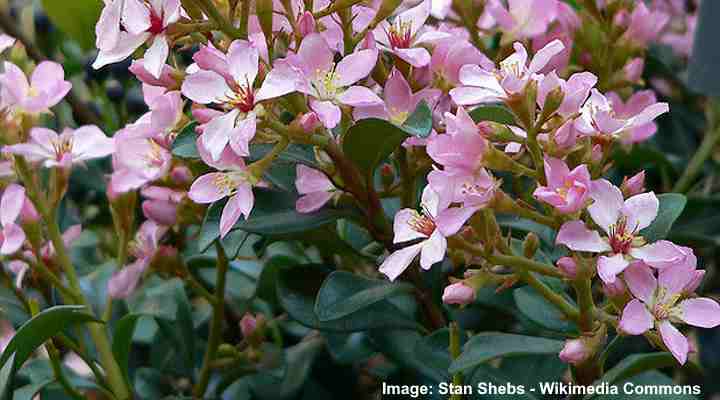
Indian hawthorn is a pink-flowering shrub with thick, dense foliage that doesn’t grow more than 6 ft. (1.8 m) tall, making it ideal for front yard landscaping. The shrub’s ornamental features include loose clusters of six-petalled, star-shaped flowers, glossy, dark green leaves, and dark blue berries.
Indian hawthorn is low-maintenance and requires minimal pruning. It performs well in sunny landscapes as a front-yard hedge, foundation planting, or container plant. This shrub is also drought-tolerant and attracts bees and butterflies, making it a great addition to pollinator gardens.
USDA Zone: 8 to 11
Sun Exposure: Full sun to light shade
Soil Type: Moist, well-drained soil
Weigela (Weigela florida)

Weigela is a rounded deciduous shrub with pretty pink funnel-shaped flowers for brightening a front yard. Thriving in full sun or dappled sunlight, the shrub features rosy-colored tubular flowers, oblong leaves, a medium growth rate, and densely growing stems. When blooming in spring and summer, the pinkish-red flowers cover the shrub.
Pink-flowering weigela shrubs grow 6 to 10 ft. (1.8 – 3 m) tall. Its attractive flowers are easy to grow and are a magnet for pollinators like bees and butterflies. Weigela is often used in front-of-house landscaping as a foundation plant, hedges, barrier, or privacy screen.
USDA Zone: 4 to 8
Sun Exposure: Full sun to partial shade
Soil Type: Clay, loamy, or sandy soil that is well-draining
Shrubby Cinquefoil (Potentilla fruticosa)

Shrubby cinquefoil is a hardy shrub, ideal for front-of-house planting to brighten landscapes with yellow flowers. The dwarf flowering shrubs have rich yellow buttercup-like flowers and glossy blue-green foliage. The yellow-flowering shrubs have a long blooming season—from late spring to early fall.
Shrubby cinquefoil doesn’t grow more than 4 feet (1.2 m) tall. It’s an incredibly tough plant that tolerates drought, heat, salt, and cold. Due to its low growth and spreading nature, it performs well in front yards as yellow flowering ground cover, foundation planting, and container planting. It’s also an attractive addition to pollinator gardens.
USDA Zone: 3 to 7
Sun Exposure: Full sun to light shade
Soil Type: Evenly moist, well-drained soil
Texas Sage (Leucophyllum frutescens)

Texas sage is a low-maintenance shrub to add purple-magenta flowers to front-of-house landscaping. The heat-tolerant shrub blooms throughout summer and fall with five-petalled purple flowers. These contrast nicely with the shrub’s small silvery-green leaves. Texas sage grows 5 to 8 ft. (1.5 – 2.4 m) tall and 5 ft. (1.8 m) wide.
Thriving in heat and drought, Texas sage is ideal for front-yard planting in southern climates. The violet-purple flowers help enhance curb appeal when planted along a foundation line or in containers beside a front entranceway. This low-maintenance plant is ideal for xeriscaping in drought-prone climates.
USDA Zone: 8 to 11
Sun Exposure: Full sun
Soil Type: Dry, well-drained soil
Mexican Orange Blossom (Choisya ternata)

Mexican orange blossom is an attractive, fragrant white-flowering shrub to enhance your home’s appearance. The eye-catching decorative shrub has five-petalled, star-shaped blossoms with a citrusy aroma. Also, it has thin, linear leaves consisting of three leaflets. Mexican orange blossom shrubs bloom in late spring and throughout the summer.
Mexican orange blossom grows 8 to 10 ft. (2.4 – 3 m) tall and has a compact, rounded shape.
USDA Zone: 8 to 10
Sun Exposure: Full sun to partial shade
Soil Type: Well-drained, fertile soil
Dwarf Pomegranate Shrub (Punica granatum var. nana)

Dwarf pomegranate is a small, compact shrub that looks attractive as a specimen plant in front yards. The ornamental shrub has stunning funnel-shaped red flowers dangling among leathery leaves. After blooming all summer long, the tree-like shrub produces small red pomegranate fruits. The dwarf pomegranate grows 2 to 4 feet (0.6 – 1.2 m) tall.
USDA Zone: 7 to 11
Sun Exposure: Full sun
Soil Type: Organically rich, dry to medium moisture soils that drain well
Related articles:
